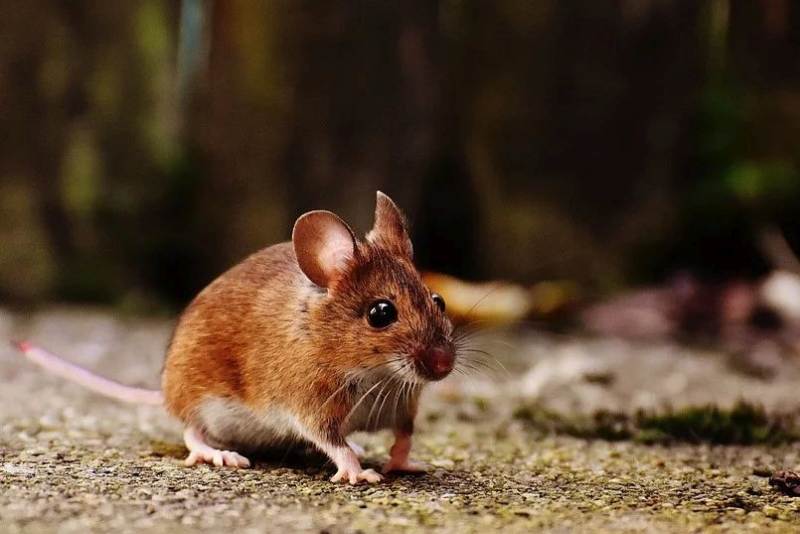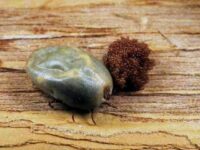Tick tubes are cardboard tubes stuffed with permethrin-coated cotton. Permethrin is a natural pesticide found in chrysanthemum flowers which is very effective against ticks. Mice find the treated cotton in tick tubes and take it to their nests to use as bedding. The permethrin on the cotton from the tick tubes kills the ticks. This is a simple but effective way to reduce the tick population in your garden.
Why Tick Tubes?
It’s not a good idea to spray the whole yard with pesticides. Not only do you poison the ticks, but you also poison your home-grown fruits and vegetables, and many beneficial garden insects die off as well. Your playing kids could also come into contact with the pesticide. This is where tick tubes come into play.
After hatching, ticks are very small and are dependent on small hosts that live close to the ground. These are usually mice, rats, and other small rodents. There can be several hundred tiny ticks on a single mouse, they drop off the mouse after the blood meal, and will wait for the next host. Since mice travel far and wide in search of food, ticks spread with the help of the mice all over the place.
So an easy way to eliminate ticks in your yard and garden is while they are still attached to mice. Tick tubes aid the process. To know all about how the tick tubes work, how effective are they, and if they can be self-made, read on.
What Are Tick Tubes?
Tick tubes are simple tubes stuffed with Permethrin-soaked cotton. Commercially available tick tubes are made of cardboard tubes. You can make tick tubes using simple materials like toilet paper rolls, PVC, and alike.
The tick tubes themselves do not kill ticks. The whole concept of tick tubes is to attract mice to pick the treated cotton wool from the tubes. Mice use cotton and fluffy stuff as nesting or bedding material in their burrows.
How Do Tick Tubes Work?
The permethrin from the cotton will stick to the mice’s fur. The ticks that are on the mouse come into contact with the substance and die. There is no risk for the mice, on the contrary, the mice that come into contact with treated cotton are freed from parasites.
In this way, mice, otherwise considered pests, are suddenly of use to us by helping get rid of ticks in our garden.

What is Permethrin?
Permethrin is a substance that is very poisonous to insects and spiders, it is a chemical compound from the group of pyrethroids. Pyrethroids are man-made chemical compounds that are similar to pyrethrins.
Pyrethrins are naturally occurring compounds in the blooms of African chrysanthemum flowers. Pyrethrins have been known and used as an insecticide for almost 100 years. (Read more about Permethrin)
Insects, spiders, and ticks take up permethrin over the body surface, it then spreads throughout the insect body. Here it acts as a neurotoxin and causes immobilization within a few minutes, if the dose is sufficiently high, the insect dies.
Permethrin is only of very low toxicity for warm-blooded animals and humans. However, skin contact with the substance in large doses can lead to itching, skin irritation, or allergies.
In the environment, permethrin is rapidly decomposed by sunlight. On plants the half-life is about 10 days, in soil, it has a half-life of about 30 days. Permethrin must not get into the water, it is highly toxic to fish.
How effective are tick tubes?
Applying tick tubes to an area can reduce the tick population in a garden or specific area. However, it must not remain the only tick control measure that you rely on.
While mice are used as host animals by ticks, and contact with the treated cotton will kill and decimate ticks, one must not forget all the other host animals such as birds, chipmunks, rabbits, possums, moles, skunks, etc., that can also spread ticks.
Tick tubes can help, but cannot end the tick problem without other control measures. In combination with other natural tick control measures, tick tubes contribute to reducing ticks in your yard.
- TESTED FOR PROTECTION: Thermacell Tick Control Tubes are a no-spray, no-mess, easy way to kill deer ticks and prevent the spread of Lyme and other diseases such as babesiosis or anaplasmosis. Developed at Harvard University School of Public Health.
- KEEP TICKS AWAY: 12 tubes provide advanced tick protection for up to ½ acre per application. Apply 2X per year for best results (spring and summer). Works best in New England, Mid-Atlantic, and Northern Woods where Lyme disease is concentrated.
- EASY TO USE: Place tubes around areas that attract mice, such as rock walls, wood piles, brush, sheds, gardens, and wooded areas. Place no more than 10 yards apart. Works with nature to reduce tick population.
- IDEAL FOR BACKYARDS: Most tick bites occur in your yard, so protect your pets and family members with Thermacell tick control that you can trust. Does not harm the environment, pets, or people.
- THERMACELL GUARANTEE: Backed by 1-year Thermacell Satisfaction Guarantee. See packaging for details
Last update on 2025-06-29 / Affiliate links / Images from Amazon Product Advertising API
Are tick tubes worth it?
Synthetic tick sprays are associated with a number of environmental and health hazards. Tick tubes are definitely worth trying, considering the dangers of using conventional chemicals.
Chemical pesticidal sprays commonly sprayed in yards and gardens also kill a variety of beneficial insects. While Permethrin is undoubtedly a chemical, it does not harm the non-target species when applied via Tick tubes.
Permethrin remains confined to the tic tubes and acts only on the ticks that come in contact with the mice that use the provided nesting material.
In addition, it only kills ticks it does not harm mice or other mammals.
The chemical remains on the fabric once dry, it does not flow away unused in large quantities as when applied spraying and therefore does not contaminate the groundwater.
Other measures to rid the garden of ticks or at least to reduce the number of ticks is the regular application of diatomaceous earth or occasionally bringing out beneficial nematodes in the garden, these little worms eat ticks from the inside out, so to speak.

Tick tubes are popular to combat ticks in yards and gardens
Permethrin is highly efficient in killing ticks. Various state and National Parks in have begun using tick tubes to control tick populations and reduce the risk of tick-transmitted diseases.
The popularity of tick rolls is probably because they are so easy to use. Simply lay them out in the garden in appropriate places frequented by mice and small rodents, that’s all.
Mice and other small rodents such as squirrels and chipmunks are primary food sources for young ticks (larva & nymph stage). So, stopping the ticks from growing at this stage will abolish their entire generation or hamper the life cycle. Used regularly, you will be able to notice the success in the years to come.
Where to place your tick tubes?
Keep a few specific places in mind while placing the tick tubes. Primarily at places close to rodent habitats and around the perimeter of your yard. It will aid the mice in finding the tubes faster, leading to the quicker elimination of ticks. You can place the tick tubes under logs or rocks or even hide in a leaf litter to keep them dryer for long.
When placing the tick tubes, make sure they are not too far apart, a maximum of 10 yards is a good distance. Close to known mice strongholds place them a bit closer. Rather buy some extra tubes and put a few more in your yard, they don’t cost much and ultimately you want to reduce the ticks. Anyways, experiment and see what works the best in your yard to get rid of ticks. If you happen to see no activity in the tube in a few weeks, you can change the location.

When to use tick tubes?
It is best to use the tick tubes twice a year, so you can build an effective tick control. In the first round place them in spring, at the beginning of the warm season, March or April is a good time. This is also the time when many rodents emerge from their winter dens.
In autumn it’s time to replace the tick tubes with new ones. Autumn is the time when many rodents build their winter nests. That way you ensure that enough new nest material that effectively acts against ticks is available for nest building.
Can you make your own tick tubes?
Technically, tick tubes are nothing but cardboard tubes filled with permethrin-soaked cotton. These will be distributed in your garden to play their part in killing ticks. You can make a tick tube using simple items like cotton balls, permethrin spray, empty toilet paper rolls, and alike.
All you need to do is spray the cotton with the chemical, stuff them in the tubes and position them across your lawns and yards. Place them closer to burrows and rodent habitats for more effectiveness.
It is a very inexpensive alternative compared to the commercial ones. You can make them with the active ingredient costing about $20, lasting for numerous usages.
What do we need for a DIY tick tube?
- Permethrin insect repellent in a spray bottle
- Empty Toilet paper rolls
- Cotton Balls or lint
- A cardboard box
- Gloves and Mask
- A mixing container
How to make your own tick tubes?
Preparation of the stuffing materials.
- Put on gloves, protective eyewear, and a mask while working with permethrin.
- Skip the next two points if you bought a ready-to-use permethrin mixture in a spray bottle.
- Dilute the chemical with water in the given ratio as per instructions on the product. Prepare this solution in a mixing container.
- Dip the cotton balls and let them soak in the solution. Use a pair of tongs to stir or pick them up. Transfer the cotton balls onto an empty plastic container and allow them to dry.
- Alternatively, you can spray the solution of permethrin and water onto the dryer lint or cotton balls. Let them dry before turning them around to treat on the other side.
How to make a tube?
- Stuff the dried lint/ cotton balls into the paper rolls. You can put 3-5 balls in each tube or up to two-thirds of it. Just enough that the cotton stays in there and the ends are open for the mice or other rodents to enter.
- Your tick tubes are ready to set across your yard. Ideally, place them across 10 to 15 feet around the perimeter. Ensure you place the tick tubes where the rodents are likely to find them.
Is DIY cheaper to buy considering the work involved?
Commercially available tick tubes cost about $50 a year for half an acre’s treatment. Making a tick tube yourself will cost you about a quarter in materials plus your time. For example, you buy a bottle of permethrin that will cost you a maximum of $20 for more than a year. Other things you will need are an empty toilet paper roll, a cardboard box, and the like. You can calculate for yourself whether making a tick tube yourself is more convenient than buying the lot.
In my opinion, it is not worth the effort to make tick tubes yourself. On the one hand, they are cheap to buy and on the other hand, making them can be quite messy and time-consuming.
How long do DIY tubes last?
The active substance in the tick tubes breaks down quite slowly in the dark so that the effectiveness of the tick tubes lasts for up to 150 days. It will be of shorter duration should the tubes be placed in the sun
However, check for the weather patterns in your area for their appropriate application. Most commonly, April and July are the months of application. Replacing the tick tubes twice a year must be efficient. Ideally, consider spring and late summer as the best time for a replacement. That’s when the nymphs emerge or the larvae hatch.
The tubes will deteriorate over time. You have the option of making more sturdy ones using PVC pipes. It is easy to refill and will have a longer life. It will get easier to locate the tick tubes by painting them bright.
Are DIY Tick Tubes Safe?
Commercially available ready-to-use products such as Thermacell Tick Control Tubes are safe when used as directed. There are a couple of points one needs to consider before making a tick tube of your own.
Firstly permethrin can be highly toxic to a few non-target species and the environment. Secondly, these synthetics are illegal to use for purposes beyond the indication on the label.
Cornell University points out that commercially formulated tick tubes are effective in combating ticks. While DIY permethrin tick tubes may harm other animals instead of being effective on ticks. Moreover, they might not work because permethrin formulations are developed for other uses listed on the label. The ones sold commercially are specifically designed to control ticks on mice will have a suitable permethrin combination.
Permethrin in concentrated form is toxic to cats. When the cats feed on mice contaminated with permethrin, it is a concern how the chemical enters the food chain. If cats eat mice contaminated with permethrin, it can make the cat very ill and even kill the cat if the permethrin dose is sufficiently high. Bumblebees are known to nest in deserted mouse burrows and may come in contact with the chemical.
While making a tick tube, one needs to consider various aspects of the environment and health. If we aren’t equipped enough for it, it’s better to go the extra mile and buy commercially available products. We can ensure safety, and legality and be responsible for our choices.




